Displaying items by tag: virtual marks
In view of the light wind forecast this weekend ISORA are making provisions for a finish outside Dublin Bay for its fourth race of the series from Holyhead to Dun Laoghaire tomorrow. ISORA will also be using virtual waypoints for the 50–mile race.
The forecast appears to be no deterrent as a bumper fleet of 29 has confirmed for the Irish Sea duel. The ISORA fleet nearly broke the 30–boat ceiling except for two unavoidable last minute pull–outs this morning.
The reason behind a Kish light as opposed to a Pier finish is that it is envisaged that there will be no wind in the bay when the fleet arrives late tomorrow afternoon.
The tracker managed finish line – between North Kish and Kish light will give accurate crossing times to within approx five seconds. Is this is the first time an offshore race has been 100% finished using technology alone?
#isora – The arrival of three Howth Yacht Club boats onto the ISORA scene this season has produced immediate results with HYC entry Dux, an X302 yacht skippered by Anthony Gore-Grimes winning the first ISORA race from Dún Laoghaire to Arklow on Saturday.
Although the strong winds and big seas cancelled most of the local inshore racing for Dublin Bay Sailing Club (DBSC), the 15–offshore yachts came to the line off Dun Laoghaire's East pier in what was some of the strongest breezes of the day. Dux followed by top performing J109 Ruth (Liam Shanahan of the National Yacht Club) made the best of the 40 – knot southerly winds that saw a number of retirals on the upwind leg along the Dublin and Wicklow coasts. Conditions dictated a shortened course to the Wicklow outfall buoy instead of North Arklow, a reduced distance of some 38 miles instead of 50 that produced an early (and welcome) high speed reaching leg back to Dublin Bay.
The provisional results for Race 1a - the Dún Laoghaire day race (incorporating the first Royal Alfred Yacht Club Coastal Series) is available to download below as a jpeg file.
In a move that has drawn the international support of ISAF's offshore working party, the ISORA crews are experimenting with iphone navigation during the race and 'virtual marks' to adjust the courses.
In deploying the new mobile technology ISORA has teamed up with app developer 'Predict Wind Tracker'.
Unfortunately on Saturday, ISORA did not get to use them to full effect. The weather was so awful that the basis of the course was to keep as close to land as possible but away from banks and headlands.
This, says Peter Ryan of ISORA, is a cost effective method of recording any offshore race that can be viewed live and also replayed after the event. ISAF's David Brunskill has offered to judge any issues surrounding the use of the virtual marks.

First race winner Dux sailed by seasoned campaigner Anthony Gore-Grimes' Photo: Robert Bateman
Ryan adds that if the innovative approach to setting courses is successful, 'it will radically change offshore racing to the betterment of all', a sentiment supported by the world sailing body.
The next race is the Holyhead to Dún Laoghaire qualifying race on 10th May. This is followed by the return race from Dún Laoghaire to Holyhead on 24th May. One of the highlights of the ISORA series this year is the Midnight Race from Liverpool to Douglas on 6th June.
New Race From Conwy Features in 2012 ISORA Calendar
It was agreed that virtual marks would be in fixed positions on a trial basis. ISORA Commodore Peter Ryan believes it will 'revolutionise' offshore racing in the Irish Sea and produce better and more exciting racing.

The new ISORA waypoint positions
It was also agreed at the weekend's agm at the National Yacht Club in Dun Laoghaire that there would be two "Restricted / Silver Fleet" classes. The decision of what boats qualify for these classes will be made by the Sailing Committee prior to the first race. It is hoped that this will allow a fairer spread of prizes.
Virtual Waypoints Coordinates:ISORA A N52 45.000 W5 08.000
ISORA B N52 45.000 W5 40.000
ISORA C N53 06.000 W5 08.000
ISORA D N53 20.000 W5 08.000
ISORA E N53 20.000 W5 40.000
ISORA F N53 35.000 W5 08.000
ISORA G N53 35.000 W5 40.000
Preliminary Race Programme 2012
28th April - ISORA / RAYC / Lee Overlay Day Race - (50 miles)
Dun Laoghaire to Nt. Arklow Cardinal
5th May - ISORA Offshore - Dun Laoghaire to Holyhead (60 miles)
Qulaifying Race
19th May - ISORA Offshore - Conwy to Howth (100 miles)
Qulaifying Race
2nd June - ISORA Offshore - Pwllheli to Wicklow (100 miles)
Qulaifying Race
27th July - ISORA / RAYC / Lee Overlay Night Race - (35 miles)
Dun Laoghaire to Nt. India Qulaifying Race
18th August - ISORA Offshore - (75 miles) Qulaifying Race
Dun Laoghaire – Pwllheli (T.B.C)
1st September - ISORA / RAYC / Lee Overlay Day Race - (54 miles)
Dun Laoghaire to M2
8th September - ISORA Offshore - Pwllheli to Howth. (80 Miles)
James Eadie Race – Qulaifying Race
Overall Series: To win the overall ISORA series for the Wolf's Head Trophy boats must complete 2
of the 6 "Qualifying". Points for the overall series will then be taken from the best 5
results. Prizes will be awarded for a separate series to include all races in the
schedule.
All races will have a weighting applied.
There will be two Day Races starting and finishing in Pwllheli – dates TBC.































































